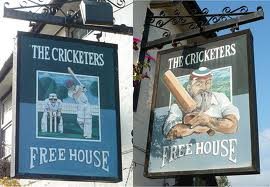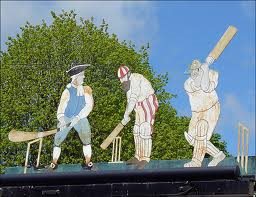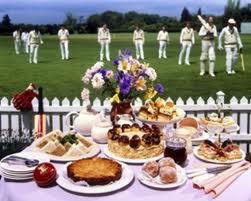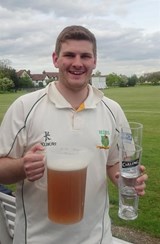'Cricket' Pubs and Teas
* * * *
In the middle ages, most ordinary folk didn't venture too far from their village and the local inn was the place for social gathering. Naturally, that involved a glass or two of ale which was drunk by just about everyone because it was cheap. 'I would give all my fame for a pot of ale and safety' wrote Shakespeare (Henry V). For generations, beer was the preferred drink of Essex cricketers.
Signs and Names
Landlords of inns and taverns hung illustrated signs outside their establishments for ease of identification - and an early form of advertising of course. In 1389, Richard II passed a law that compelled landlords to hang out a sign - in order to make the inn easily visibly to government inspectors who made regulars checks on ale quality. An inn's name often evolved from its illustration. Popular names included those with a religious theme ('The Cross' in Great Bromley, 'The Angel' in Waltham Abbey) or connected with the monarch (the 'Queen's Head', in Burnham-on-Crouch, 'The Crown' in Little Walden) or related to animals (the 'Dog & Partridge' in North Stifford, 'The Bull in Blackmore). The brightly-decorated hand-painted inn/pub sign is unique to England and a much-loved part of our history.

'The Cricketers' at Goldhanger
Some of the more shrewd cricketers saw the inn as a means of making a handsome living for themselves. John Wisden (creator of the Wisden cricket almanack) owned 'The Cricketers' in West Sussex and Jim Southerton (who played for England in the first two Test matches in Australia) ran 'The Cricketers' in Mitcham, Surrey. Landlords of inns identified a lucrative business opportunity - selling ale and providing food for cricket players and spectators, both before and after, and sometimes during, cricket matches. In order to attract spectators (paying customers) they would actively promote upcoming matches by displaying posters in their inn and local shops. And they erected booths and marquees around the ground from which they sold ale and pies and draped out colourful bunting to create a festival atmosphere.
Many clubs adopted the local inn as their 'clubhouse' - where they held their management meetings, AGMs and social functions . It was also the place for after-match debate and analysis - more animated after a defeat of course! Why didn't the skipper use Jim our spinner? Why did George bat at No. 9? If only Patrick hadn't dropped that catch. . .a lot of 'whys' and 'ifs'. A thorough scan of the scorebook was studiously conducted followed by a drunken discussion about what needed to be done before next week's local derby match. After-match deliberation is still a ritual among players.
Food and alcoholic beverage have always been associated with the game of cricket. William Nicholson, president of MCC in 1879, was a successful gin distiller who financed the construction of the new pavilion at Lord's in 1890. The father of Cyril Buxton (captain of Essex CCC between 1889 and 1891) ran the well-known family brewery that later merged with Truman's brewery and in 1999, Shepherd Neame, the country's oldest brewer, began its sponsorship of the Essex League that lasted until 2020.
One of the greatest teams in England in the late eighteenth/early nineteenth century was Hornchurch Cricket Club (established in 1783) whose players were reputed to provide fine after-match hospitality. They often entertained opponents at 'The Bull Inn' (now called 'The Fatling') in the High Street. In 1825, after a return match against Fobbing Cricket Club, 'the gentlemen retired to 'The Bull Inn' where, after partaking of a most excellent dinner provided by Mr Gooch the landlord, they were amused by some excellent songs and the evening passed with the greatest conviviality'.

'The Three Willows' at Birchanger
Although nearly all cricket clubs in Essex have their own clubhouse and well-stocked bar, the county is fortunate to have a number of excellent 'cricket' pubs within its boundary.
Birchanger 'The Three Willows'
Bradwell-on-Sea 'The Cricketers'
Chelmsford 'The Cricketers'
Clavering 'The Cricketers'
Danbury 'The Cricketers Arms'
Fordham Heath 'The Cricketers'
Fryerning 'The Cricketers'
Goldhanger 'The Cricketers'
Rickling Green 'The Cricketers Arms'
Westcliff-on-Sea 'The Cricketers'
Woodford Green 'The Cricketers'

'The Cricketers' at Fordham Heath
................................................
Hungry Cricketers
We all know that Essex-born Jamie Oliver learnt his trade at his father's restaurant, 'The Cricketers' in Clavering - a pleasant place to celebrate a special occasion/anniversary. The members of Dedham Cricket Club are fortunate to have the highly-acclaimed 'La Talbooth' on their doorstep and Dunmow Cricket Club members have the well-regarded 'The Flitch of Bacon' where they can enjoy fine food and real ale. And the members of Stansted Cricket Club can pop around the corner to delightful Bentfield Green where the 'Rose & Crown' (Essex Tourism's 'Best Traditional Pub in Essex' Award and Essex Life Magazine's 'Best Family Dining Pub in Essex' Award) welcomes cricketers from all around the county. Although cricketers can enjoy a late-night bite at these superb establishments, a chicken vindaloo and onion bhaji at their local Indian restaurant is probably the meal of choice for most club cricketers of Essex.
And these excellent pubs and restaurants can source first-class products from within the county - jams from Wilkin & Son in Tiptree; juices from Britvic in Chelmsford; oysters from Mersea Island; whitebait from Southend-on-Sea; saddleback pigs from Hornchurch and outstanding wines from the New Hall Vineyard in Purleigh. Essex is also blessed with fine draught and bottled beers produced by, among others, The Brentwood Brewing Company and The Felstar Brewery in Felsted.
Delicious Teas
From the eighteenth century, start times for cricket matches varied. 'Wickets shall be pitched at 10 o'clock precisely' proclaimed a match poster in 1815. Players often ate a meal before a match as well as after close of play. Spectators did likewise, although in the 'Grand' matches, they ate prodigious amounts and drank pints aplenty throughout the match, either at the nearby inn or in the booths erected around the ground.
The taking of afternoon tea in England has been widely credited to Anna Russell, the Duchess of Bedford, in the nineteenth century. However, the former England Test captain Tony Lewis, in his 1987 book Double Century, suggests that it was the 3rd Duke of Dorset who brought the habit to England after his stint as Ambassador to France between 1783 and 1789. The Duke had befriended, intimately say some, Marie Antoinette, who introduced him to afternoon tea (a custom largely a practice of the French aristocracy that had existed for some years). Coincidentally, the Earl of Sandwich, the nobleman gambler who is credited with the creation of our good old bread sandwich, was a founder member of the MCC.

The cricket tea is as much a part of the game as the playing of the match itself: what other sport goes to so much trouble to produce a lavish spread for its players midway through a keenly-fought contest? And afterwards, the players attempt to run around the field of play! The cricket tea is a tradition among cricket-playing countries around the world. It is, of course, common courtesy to offer a meal to your opponents - just as you do when inviting friends to your home.
Wives, mums and girlfriends have been producing cricket teas for generations. With their homemade cakes and scones and cheese and cucumber sandwiches (in recent years we've seen the arrival of vegetable samosas and chicken wraps), their baking efforts are performed entirely voluntarily. Like many other clubs throughout the county, Belhus Cricket Club has always taken pride in producing a fine spread for its opponents. Being past winners on two occasions of the 'Best Hospitality' table in the Essex League, the club will continue to extend a warm welcome to players and spectators from visiting clubs.
However, when the Covid pandemic struck in 2020, all scheduled matches in the first half of the
season were cancelled. And when matches resumed in mid-July, one of the restrictions put in place was that the traditional (by the Home team) provision of sandwiches and cakes for tea should cease. So instead of the communal tea-table as we had known and enjoyed it for decades, came the requirement that players
should bring their own teas to matches. It was a major change to the
afternoon game as we knew it, but players soon became accustomed to it. For the ensuing years, just 1st XI and 2nd XI teams in the Hamro Foundation Essex League were required to produce teas (and lunches for Premier Division matches) for Home matches. All other teams had the option of providing teas or not.
Today, non-league/friendly matches, be they Saturday or Sunday, tend to see the 'bring your own tea' arrangement.

Members of Belhus CC still enjoy after-match hospitality
* * * *
Recommended reading
'The Beer Lover's Guide to Cricket'. Richard Poltz, 2007
'Inns and Outs'. Anthony Collins and Geoff Wellsteed, 2010
Denis Reed 2023